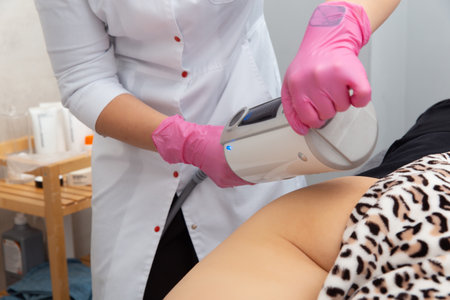Understanding Skin Types and Ethnic Diversity in the UK
The United Kingdom is renowned for its rich multicultural society, reflected in the diversity of skin types seen within clinics and aesthetic practices across the country. To deliver effective and safe laser treatments, it is essential for practitioners to have a robust understanding of these differences. The Fitzpatrick scale, widely used in clinical settings, classifies skin into six types based on its response to ultraviolet (UV) light exposure—ranging from very fair (Type I) to deeply pigmented dark brown or black skin (Type VI). Each type presents unique characteristics and varying levels of melanin, which directly influence how skin responds to laser energy.
Across different ethnic backgrounds—be it Caucasian, Asian, Black African, Middle Eastern, or mixed heritage—there are distinct physiological attributes that impact treatment outcomes. For example, higher melanin content in darker skin types can increase the risk of post-inflammatory hyperpigmentation (PIH) or hypopigmentation when exposed to inappropriate laser settings. Conversely, fairer skin types may be more susceptible to erythema or burns if not treated correctly. Recognising these nuances is particularly vital in the UK, where patient populations represent a wide spectrum of ethnicities and skin tones.
Incorporating this awareness into everyday practice ensures that all patients receive tailored care that respects their individual skin biology. By appreciating the significance of ethnic diversity and leveraging tools like the Fitzpatrick scale, practitioners can better assess risk factors and design bespoke laser treatment protocols. Ultimately, acknowledging the UK’s multicultural demographic is not only best practice but fundamental to providing safe, inclusive, and effective aesthetic care.
2. Key Considerations for Laser Treatment in Diverse Skin Tones
In the context of the UK’s multicultural society, customising laser treatments for different skin types is essential to ensure both safety and efficacy. Understanding the unique characteristics and responses of various skin tones—especially among ethnic minorities—is crucial when planning and performing laser procedures.
Identifying Risks: Hyperpigmentation and Scarring
The risk profile for laser treatments differs significantly between lighter and darker skin types. Individuals with Fitzpatrick Skin Types IV to VI, common in Black, South Asian, and Middle Eastern populations, are more prone to post-inflammatory hyperpigmentation (PIH) and scarring following laser therapy. Therefore, practitioners must be vigilant in selecting appropriate settings and technologies.
Main Risks by Skin Type
| Fitzpatrick Skin Type | Ethnic Background Examples | Main Risks |
|---|---|---|
| I-II | Caucasian, Northern European | Erythema, transient pigmentary changes |
| III-IV | Mediterranean, South Asian | PIH, mild scarring risk |
| V-VI | African-Caribbean, African, Middle Eastern | High PIH risk, keloid scarring |
Differences in Skin Response Among Ethnic Backgrounds
The melanin content and distribution in the epidermis directly affect how skin absorbs laser energy. Darker skin types absorb more laser energy in the superficial layers, increasing the risk of burns and pigment alteration. This necessitates a tailored approach that takes into account:
- Laser wavelength selection: Longer wavelengths such as Nd:YAG 1064nm are generally safer for darker skin as they penetrate deeper with less melanin absorption.
- Energy fluence adjustment: Lower fluence settings help minimise thermal injury while achieving desired results.
- Cooling mechanisms: Integrated cooling devices protect the epidermis during treatment, reducing adverse outcomes.
- Pretreatment assessment: A thorough consultation to assess skin type, history of pigmentation disorders, and previous reactions to treatments is vital.
Best Practice Summary Table
| Consideration | Lighter Skin (I-III) | Darker Skin (IV-VI) |
|---|---|---|
| Laser Type | Aleaxandrite, Diode | Nd:YAG 1064nm preferred |
| Fluence Level | Standard protocols | Start lower, titrate slowly |
| Epidermal Cooling | Recommended but optional | Essential for safety |
| Pretreatment Patch Test | Advised for sensitive patients | Mandatory for all patients |
| Follow-up Schedule | Routine follow-up | Tighter follow-up due to higher PIH risk |
This awareness of differences across ethnic backgrounds ensures that practitioners uphold best practice standards and deliver safe, effective results for all patients seeking laser treatments within the UK’s diverse population.

3. Selecting and Adjusting Laser Modalities
When customising laser treatments for diverse skin types, particularly within the ethnically varied UK population, the selection and adjustment of laser modalities is critical. Adhering to best practices in wavelength, pulse duration, and fluence not only enhances clinical outcomes but also ensures patient safety.
Wavelength Selection for Skin Type
The choice of wavelength plays a pivotal role in minimising complications such as post-inflammatory hyperpigmentation or burns. For individuals with lighter Fitzpatrick skin types (I–III), shorter wavelengths like 755 nm Alexandrite lasers are generally effective. However, for darker skin types (IV–VI), longer wavelengths such as the 1064 nm Nd:YAG are preferred due to their deeper penetration and reduced melanin absorption, lowering the risk of epidermal damage.
Pulse Duration and Fluence Adjustment
Proper adjustment of pulse duration is essential in matching the thermal relaxation time of targeted chromophores while avoiding excessive heat delivery to surrounding tissue. Shorter pulse durations suit finer hair or superficial lesions, whereas longer pulses are advisable for thicker hair or deeper targets—particularly important for ethnic skin types prone to scarring. Fluence should be carefully titrated: start low and increase gradually, always monitoring for adverse responses. This conservative approach is especially vital in British clinics serving a broad spectrum of skin tones.
Ensuring Equipment Safety Standards
British clinics are bound by strict equipment safety standards, such as those set by the Care Quality Commission (CQC) and British Standards Institution (BSI). All devices should be CE-marked and regularly serviced. Practitioners must be trained to use cooling methods—like contact cooling or cryogen spray—to protect the epidermis during treatment. Patch testing is strongly recommended before full-scale procedures, particularly for patients with darker skin or a history of sensitivity.
By meticulously selecting and adjusting laser parameters according to individual skin characteristics—and following established UK safety protocols—clinicians can deliver effective, safe treatments tailored to Britain’s ethnically diverse population.
4. Pre-Procedure Assessment and Patient Education
Ensuring optimal outcomes in laser treatments for diverse skin types begins with a comprehensive pre-procedure assessment and robust patient education. The consultation phase should be both clinically thorough and culturally sensitive, considering the unique physiological and psychosocial factors relevant to ethnic diversity.
Thorough Consultation and Medical History Review
A detailed consultation is crucial. Practitioners must assess Fitzpatrick skin type, history of hyperpigmentation or keloid scarring, previous cosmetic procedures, current medications, and underlying health conditions that may influence healing or increase risk of adverse reactions. It is equally important to enquire about traditional skincare practices that may affect treatment outcomes.
| Consultation Element | Key Considerations | Culturally Sensitive Strategies |
|---|---|---|
| Skin Type Assessment | Identify Fitzpatrick classification; note any signs of photodamage or pigmentation disorders. | Avoid assumptions based on appearance; allow patients to self-identify their background. |
| Medical History | Review for allergies, medications, autoimmune conditions, and family history of scarring. | Use interpreters when needed; provide translated materials if English proficiency is limited. |
| Lifestyle & Cultural Practices | Discuss use of herbal remedies, traditional oils, or topical agents not commonly recorded in Western medicine. | Respect cultural norms; invite open disclosure without judgement. |
| Previous Aesthetic Procedures | Document prior laser treatments, chemical peels, or microneedling sessions. | Sensitively ask about treatments performed abroad or by non-medical practitioners. |
Managing Patient Expectations
Clear communication regarding realistic results and potential risks is essential. Practitioners should explain that outcomes can vary based on skin type, with particular attention to the increased risk of post-inflammatory hyperpigmentation (PIH) or hypopigmentation in darker skin tones. It is important to discuss the number of sessions required, possible downtime, and necessary aftercare to minimise complications.
Culturally Sensitive Communication Techniques
- Active Listening: Allow patients to voice concerns and preferences without interruption.
- Avoid Jargon: Use plain English; clarify medical terms where necessary.
- Visual Aids: Offer before-and-after photos of individuals with similar skin types for reference.
- Inclusion of Family: In some cultures, decision-making involves family members—invite them into consultations when appropriate.
- Acknowledgement of Cultural Beliefs: Respect beliefs regarding beauty standards or skin tone changes without imposing personal views.
Summary Table: Key Components of a Culturally Attuned Assessment
| Assessment Area | Cultural Sensitivity Focus |
|---|---|
| History Taking | Open-ended questions about traditional practices and expectations |
| Treatment Planning | Bespoke approach respecting individual values and desired outcomes |
| Risk Discussion | Transparency about risks unique to certain skin types; reassurance through education |
| Consent Process | Sufficient time for questions; materials provided in preferred language where possible |
A meticulous pre-procedure assessment combined with culturally competent patient education sets the foundation for safe, effective laser treatments tailored to the UK’s ethnically diverse population.
5. Post-Treatment Care and Managing Complications
Effective Post-Laser Care Protocols for Diverse Skin Types
Ensuring optimal recovery and minimising complications after laser treatments is essential, particularly when working with the UK’s ethnically diverse population. Tailored post-laser care protocols can significantly reduce the risk of adverse outcomes such as pigmentation changes or scarring. Immediate application of a gentle, cooling compress and fragrance-free moisturisers is advisable to soothe the skin, followed by strict photoprotection. Patients should be encouraged to avoid direct sunlight and use broad-spectrum SPF 50+ sunscreen daily, reflecting common UK dermatological guidance.
Guidance on Topical Agents
The choice of topical agents must be individualised, especially in patients with higher Fitzpatrick skin types who may be prone to post-inflammatory hyperpigmentation (PIH). Non-comedogenic emollients and mild steroid creams can help manage erythema and swelling in the initial days post-procedure. For ongoing care, incorporation of pigment-stabilising agents such as azelaic acid or niacinamide is recommended over hydroquinone, which is less commonly used and more tightly regulated in the UK. Instruct patients to avoid irritants like retinoids or exfoliating acids for at least one week post-treatment to prevent sensitisation.
Protocols for Managing Pigmentation Changes
Pigmentation alterations remain a primary concern following laser therapies, particularly among individuals with melanin-rich skin. Early intervention is key: if hyperpigmentation develops, a regimen involving topical antioxidants (e.g., vitamin C serums) and prescription-strength pigment modulators under professional supervision should be initiated. For hypopigmentation, referral to a consultant dermatologist may be necessary for assessment and management, including options such as camouflage cosmetics that are widely available through NHS services in the UK.
Aligning with UK Skincare Practices
It is vital to align post-laser care advice with established UK skincare practices, ensuring recommendations are practical and accessible. Encourage gentle cleansing routines using products free from sulphates and synthetic fragrances. Emphasise the importance of routine follow-up appointments to monitor healing and provide support—this proactive approach helps foster trust and delivers safer outcomes for all ethnic groups undergoing laser procedures.
6. Training, Regulation, and Ethical Responsibility
When customising laser treatments for diverse skin types in the UK, robust training, regulation, and an unwavering commitment to ethical practice are essential. The UK aesthetic industry is governed by a complex regulatory framework that includes guidelines from the Care Quality Commission (CQC) and recommendations from professional bodies such as the British Association of Dermatologists (BAD) and Joint Council for Cosmetic Practitioners (JCCP). Adhering to these standards ensures client safety and optimal outcomes, particularly for patients from ethnic backgrounds with higher Fitzpatrick skin types.
Professional Training Standards
Practitioners must undergo comprehensive training that not only covers the technical aspects of laser devices but also focuses on the unique responses of different skin tones to energy-based treatments. Special attention should be paid to understanding the risks of post-inflammatory hyperpigmentation, burns, and scarring in darker skin types. Continuous professional development (CPD) courses and hands-on workshops are vital for maintaining high standards and staying abreast of evolving best practices.
Regulatory Requirements in the UK
The regulatory landscape in the UK requires practitioners offering laser treatments to operate within strict legal frameworks. While non-surgical cosmetic procedures currently face less stringent statutory regulation compared to medical interventions, reputable clinics voluntarily adhere to CQC guidance and JCCP registers. This commitment demonstrates accountability and instils public confidence—especially crucial when treating ethnically diverse communities who may have heightened concerns about safety and efficacy.
Ethical Imperatives: Inclusivity and Safety
Ethical responsibility goes beyond legal compliance. Practitioners must foster inclusivity by ensuring their protocols are safe and effective for all skin types, not just those traditionally represented in clinical trials or marketing materials. Open communication, informed consent tailored to each patient’s cultural background, and transparent discussion of risks are fundamental. An ethical approach positions clinics as trusted providers in multicultural Britain and helps address historical inequalities in access to safe aesthetic care.
In summary, advancing inclusivity in laser aesthetics requires a holistic approach: rigorous training, adherence to UK regulations, and a steadfast ethical commitment to safety across all skin types. By prioritising these values, practitioners can deliver personalised care that respects both individual diversity and the highest professional standards.


